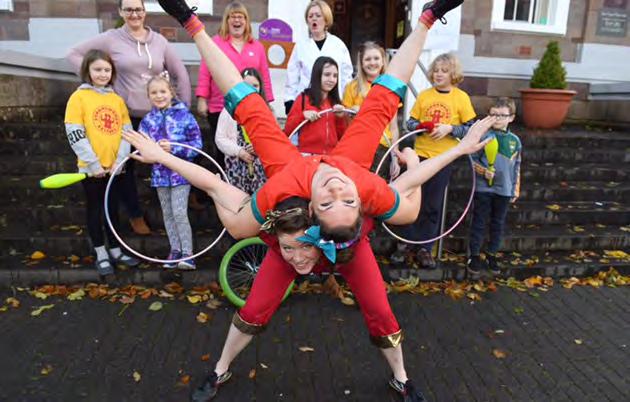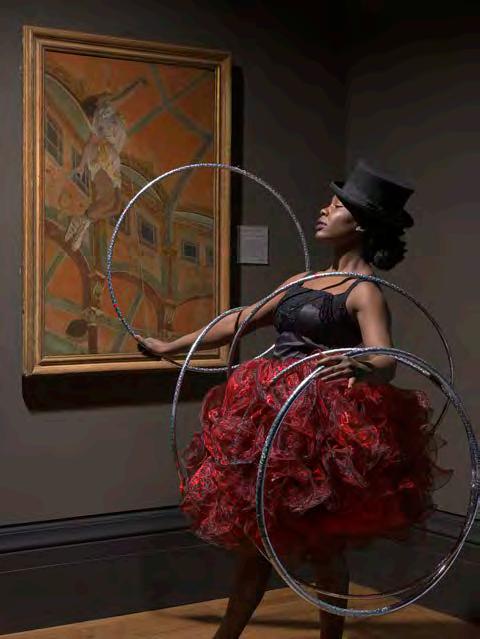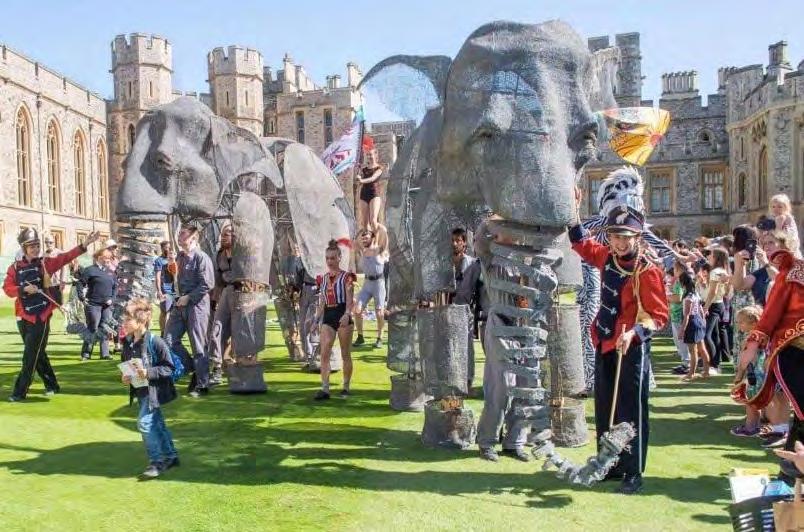
8 minute read
Throw your hat in the ring. Why museums and circus work so well together
from Museum Ireland, Vol. 27. Widdis, B. (Ed.). Irish Museums Association, Dublin (2021)
by irishmuseums
MUSEUM IRELAND 2020
Throw your hat in the ring. Why museums and circus work so well together
Advertisement
Dea Birkett
Unicycling, cartwheels and custard juggling in a museum? You must be joking. What curator, or even the most eager learning officer, would allow such antics in their esteemed galleries? The answer is: more and more of them.
In the last few years, there’s been a remarkable shift in museums in welcoming performance, and circus performance in particular. It began in 2018, the 250th anniversary of the very first circus, which was marked by over 500 events Ireland and UK-wide, coordinated by the not-for-profit Circus250 production company. Of these, about a fifth took place in museums. They included the Circus Work exhibition of Peter Lavery’s photographs of life behind the ring doors at the Harley Gallery, Nottinghamshire and Royal West of England Academy, Bristol; Performers, Politics and Pop Culture at the National Centre for Craft and Design in Lincolnshire; The Art of the Show at the National Gallery in Dublin showcasing their circus poster collection; and Circus. Show of Shows! at Weston Park Museum, Sheffield, which toured to Time and Tide Museum, Great Yarmouth and Discovery Museum, Newcastle upon Tyne. Live circus performance and circus skills workshops were often programmed alongside many of these exhibitions, doing cartwheels and custard throwing among them.
Museums that had never before seen a clown’s nose or sparkly leotard, embraced, explored and enthused about circus, its art, its social significance, its history and its science. The Science Museum, London, held one of its wellknown ‘Lates’ on the science of circus, and the entertainment at the Museum’s annual Director’s Dinner was provided by aerial hoop, stilt walkers and jugglers. The Circus250 year opened in January with a 4-metre-high handstand act taking place under Hope, the giant blue whale in the Natural History Museum London’s stunning Hintze Hall. We called it ‘Handstand for Hope’.
My own background is both as a circus performer and museum advocate. I began life as an artiste in a traditional tented touring circus and am now director of Circus250. In between, I founded and ran Kids in Museums, the UK based charity, part of Arts Council England’s National Portfolio, that agitated for and supported better family and child inclusion in museums, in particular for those who hadn’t visited before. So when I ran back to the circus four years ago, to run Circus250 and coordinate the year-round anniversary celebrations, I took with me a passion for museums and a knowledge that they were spaces open to challenge and change.
Why have many museums rolled up to circus? Circus is live performance, often in a temporary space, involving a great deal of movement. Museums, in contrast, are stuffed with static things, their objects mostly displayed on walls and pedestals and in glass cabinets. Unlike the sensory-rich circus, museums have no smell and
Irish premiere of StrongWomen Science at Kerry County Museum, November 2018, during National Science Week.
Credit: Circus250
discourage touch. Although many museums have digitised collections, in an increasingly virtual world, museums and circuses share a Unique Selling Point. They are both about the real.
There are many benefits for a museum that embraces circus. Circus attracts visitors, especially families, to a museum that might not otherwise venture inside. It’s the most accessible of art forms; no one looks awkwardly at their friend half way through a circus performance and whispers, ‘What’s that about???’ Circus may make you gasp, but there’s nothing frightening about it. No one worries they are not clever or educated enough to understand it. There are few words, so it doesn’t rely on literacy or even speaking the same language as the performers. Everyone, of any age, enjoys it. I walked around the National Gallery’s The Art of the Show with my Auntie, then again with my teenagers, once alone, and then with Dr Panti Bliss. I think every one of them enjoyed, and each took away something special from their visit. Circus doesn’t only bring new audiences to a museum but introduces the possibility of new behaviours. Of course, these two are inextricably linked, as perceptions of proper ‘museum behaviour’ are a significant barrier to many potential visitors. At Kids in Museums, and now at CultureKids, we advocate dismantling what counts as ‘museum behaviour’ and coming to an agreement with visitors on a new code of conduct. This involves questioning assumptions about what’s considered acceptable and asking why some actions are frowned upon or forbidden.
An example is Circus250’s performance Frame: Circus for Drawing, developed for and first performed at the Royal Academy in London. In 2019, the Academy held an exhibition of the work of twentieth century painter Dame Laura Knight, best known for her circus work and in particular the spectacular The Grand Parade. To complement the exhibition, it seemed fitting to host some live circus performances. The Academy is a prestigious place, not given to allowing leaping and unicycling among the masterpieces. But by careful risk assessment, planning and frank discussion about what could go wrong, we not only juggled, unicycled and walked two-person high through

Blaze Tarsha in front of Degas’ Miss La La at the Cirque Fernando.
Credit: The National Gallery, London
the gilded galleries, but did a clown act with custard as well.
Frame is a two-performer circus show specifically designed to take place in high art galleries like the Academy, in an attempt to broaden both audiences and acceptable behaviours. The audience watches an act and, supported by an artist tutor, livedraws it as the performance continues. Each act is created with repetitive elements and performed at a slower pace, so it’s easy to capture with crayons and pencils. We wanted to use live drawing, rather than anything more static, as, for those who don’t consider themselves artists, its concentration on capturing movement and feeling rather than being accurate is liberating. At the Royal Academy, visitors/audience members could draw on the floor, on a clipboard or beany tray (particularly useful for wheelchair users for whom clipboards can be tricky to balance). After the performances, their drawings were displayed in the gallery. The event was popular with audiences, many of whom said they now felt able to invite friends to the Circus can also be used to bring fresh interpretations to familiar objects. The National Gallery in London holds Edgar Degas’ famous painting of Miss La La at the Cirque Fernando, depicting a nineteenth century black circus performer who was a superstar of her time. The painting had barely left the building for decades, but for the 250th anniversary it travelled to Sheffield Museums’ Show of Shows! exhibition. There, outside its former high art context where it had been considered as part of a French impressionist’s oeuvre, it told a different story. It was presented instead as the portrait of a powerful, wealthy, celebrated black woman living in an era in which many falsely believe there was no such thing. Sheffield Museums commissioned young black circus artist Blaze Tarsha to create an act in response to the painting, which was filmed and displayed beside it. The accessibility and immediacy of circus allowed this story to be told. And the painting was no longer just an 1879 masterpiece, but alive and with meanings for today.
Not only an individual object, but a whole space can be reinterpreted through circus. In partnership with Lost in Translation circus and the Royal Collection Trust, Circus250 staged a large-scale circus parade and performance in the quadrangle at Windsor Castle for the first time in over 150 years, including life-sized elephant puppets. This Victorian-inspired circus reinterpreted an area normally viewed by visitors as just a big bare lawn, thereby revealing and invoking how it was once a lively centre for royal entertainment.
Circus can also help explain complex and specialist ideas, which are wonderfully rife in museums and their collections, in simple and immediate ways. Science museums, in particular, can understandably struggle to convey physics, chemistry and engineering concepts in a way that makes them easy for non–specialist visitors to grasp. Our StrongWomen Science show is a circus science show for families that attempts to do just that. Words may fail to clearly explain to the nonscientist what centripetal force is, but we used some empty yoghurt pots, a paddling of yellow rubber ducks and circus skills to do a poi act, with

Victoria200 Circus at Windsor Castle.
Credit: Royal Collection Trust
the aim of demonstrating something no label nor panel could.
We discovered another unexpected benefit of working with an all-female circus troupe. The typical visitor group at the Royal Air Force Museum in London is fathers/carers and boys. When StrongWomen Science performed and gave workshops there, the number of girl visitors increased by 60 per cent. Over half of families with girl children said they’d only visited because the circus was on. At a time when there’s a rightful concern of the lack of women in STEM, enticing more girls into an aeronautical museum is a good first step to addressing this issue as well as broadening the visitor base. education rather than the curatorial department, a first in itself. The posters and paintings were hung slightly lower than usual, to make them more accessible for children. The labels were written in slightly different language to the usual house style. Circus is based on risk, and encourages others to take risks too. When we performed at the Science Museum in London, the Director came up to me, dressed in my ringmaster’s outfit and whispered conspiratorially in my ear, ‘I bet this will shake things up a bit.’
And – in case you’re still worried about welcoming unicyclists, jugglers and clowns into your galleries – the only thing we’ve ever broken is visitor numbers.
Dea Birkett is Director of CultureKids Ireland and Ringmaster for Circus250. www.circus250.org
Circus has always been a disruptor, an outsider art form set apart from the mainstream, with a capacity for disruption that accompanies it when introduced to a museum. At the National Gallery exhibition The Art of the Show, new practices emerged. The curator, Joanne Drum, was from the









